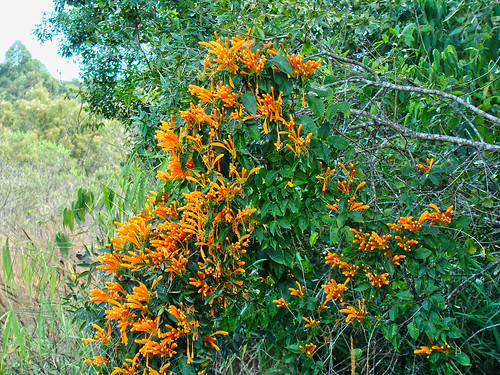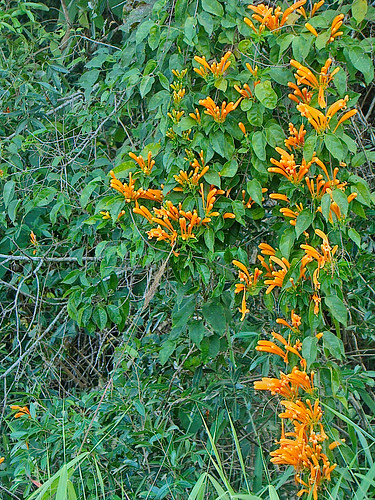Cool Beauty Tips images
posted in Chat & Forums |Check out these beauty tips images:
Cipó-de-são-joão – Pyrostegia venusta

Image by de Paula FJ
Nome Científico: Pyrostegia venusta
Sinonímia: Bignonia ignea, Bignonia venusta, Pyrostegia ignea, Bignonia tecomiflora, Pyrostegia acuminata, Pyrostegia dichotoma, Pyrostegia intaminata, Pyrostegia pallida, Pyrostegia parvifolia, Pyrostegia reticulata
Nome Popular: Cipó-de-são-joão, flor-de-são-joão, cipó-vermelho
Família: Bignoniaceae
Divisão: Angiospermae
Origem: Brasil
Ciclo de Vida: Perene
Trepadeira muito utilizada na decoração das festividades de São João em todo o Brasil. Produz muitas inflorescências, compostas de pequenas flores alongadas e alaranjadas em pleno inverno destacando-se. É uma planta interessante quando queremos ter flores vistosas nos meses frios. Cobre muito bem pérgolas, cercas, treliças, muros e caramanchões.
Devem ser cultivadas em solo fértil com regas regulares, sempre a sol pleno. Uma boa adubação com farinha de ossos e cinzas estimula uma floração abundante. É frequente observá-la nas matas a beira das estradas. Multiplica-se por sementes e por estaquia.
Medicinal
Indicações: Diarréias e desinterias, leucoderma, vitiligo.
Propriedades: Tônico.
Partes usadas: Flores, folhas e raízes.
Description
Flame vine is a vigorous, fast-growing, evergreen woody vine that blooms in winter and spring with spectacular reddish-orange flowers. The compound leaves have two or three 2-3 in (5.1-7.6 cm) oval leaflets and are arranged in pairs opposite each other on the stem. Often, the center leaflet is modified into a coiled, three-parted tendril. Flame vine branches profusely and climbs by clinging with its tendrils. The tubular flowers are about 3 in (7.6 cm) long and borne in clusters of 15-20 at the tips of branches. The corolla has five lobes which are bent backwards, and the long orange stamens and style extend beyond the tube. The flower clusters may hang down under the weight of their own beauty. Fruits are slender dry capsules about 1 ft (o.3 m) long.
Location
Pyrostegia venusta, the flame vine is native to southern Brazil, northern Argentina and Paraguay.
A climber shrub, commonly known as Flame Vine or Orange Trumpet Creeper. This evergreen shrub with its showy red-orange flowers, is original from Brazil, commonly known as Flor-de-São-João in Portuguese. This ornamental climber has become an invasive weed in São Paulo crops. The best show of Flame Vine – Pyrostegia venusta – is in June and July. In this time of the year we can see the Flame Vine climbing on trees all around in Enseada Azul. Flor-de-São-João attracts many hummingbirds.
Cipó-de-são-joão – Pyrostegia venusta

Image by de Paula FJ
Nome Científico: Pyrostegia venusta
Sinonímia: Bignonia ignea, Bignonia venusta, Pyrostegia ignea, Bignonia tecomiflora, Pyrostegia acuminata, Pyrostegia dichotoma, Pyrostegia intaminata, Pyrostegia pallida, Pyrostegia parvifolia, Pyrostegia reticulata
Nome Popular: Cipó-de-são-joão, flor-de-são-joão, cipó-vermelho
Família: Bignoniaceae
Divisão: Angiospermae
Origem: Brasil
Ciclo de Vida: Perene
Trepadeira muito utilizada na decoração das festividades de São João em todo o Brasil. Produz muitas inflorescências, compostas de pequenas flores alongadas e alaranjadas em pleno inverno destacando-se. É uma planta interessante quando queremos ter flores vistosas nos meses frios. Cobre muito bem pérgolas, cercas, treliças, muros e caramanchões.
Devem ser cultivadas em solo fértil com regas regulares, sempre a sol pleno. Uma boa adubação com farinha de ossos e cinzas estimula uma floração abundante. É frequente observá-la nas matas a beira das estradas. Multiplica-se por sementes e por estaquia.
Medicinal
Indicações: Diarréias e desinterias, leucoderma, vitiligo.
Propriedades: Tônico.
Partes usadas: Flores, folhas e raízes.
Description
Flame vine is a vigorous, fast-growing, evergreen woody vine that blooms in winter and spring with spectacular reddish-orange flowers. The compound leaves have two or three 2-3 in (5.1-7.6 cm) oval leaflets and are arranged in pairs opposite each other on the stem. Often, the center leaflet is modified into a coiled, three-parted tendril. Flame vine branches profusely and climbs by clinging with its tendrils. The tubular flowers are about 3 in (7.6 cm) long and borne in clusters of 15-20 at the tips of branches. The corolla has five lobes which are bent backwards, and the long orange stamens and style extend beyond the tube. The flower clusters may hang down under the weight of their own beauty. Fruits are slender dry capsules about 1 ft (o.3 m) long.
Location
Pyrostegia venusta, the flame vine is native to southern Brazil, northern Argentina and Paraguay.
A climber shrub, commonly known as Flame Vine or Orange Trumpet Creeper. This evergreen shrub with its showy red-orange flowers, is original from Brazil, commonly known as Flor-de-São-João in Portuguese. This ornamental climber has become an invasive weed in São Paulo crops. The best show of Flame Vine – Pyrostegia venusta – is in June and July. In this time of the year we can see the Flame Vine climbing on trees all around in Enseada Azul. Flor-de-São-João attracts many hummingbirds.
Enter the Showgirls !

Image by FredMikeRudy
Just before dusk these showgirls walked out of the casino and onto Fremont Street to pose for pictures with passers-by. Tips, while highly appreciated were not mandatory…..more a token of appreciation for their unrelenting smiles and undeniable beauty.









